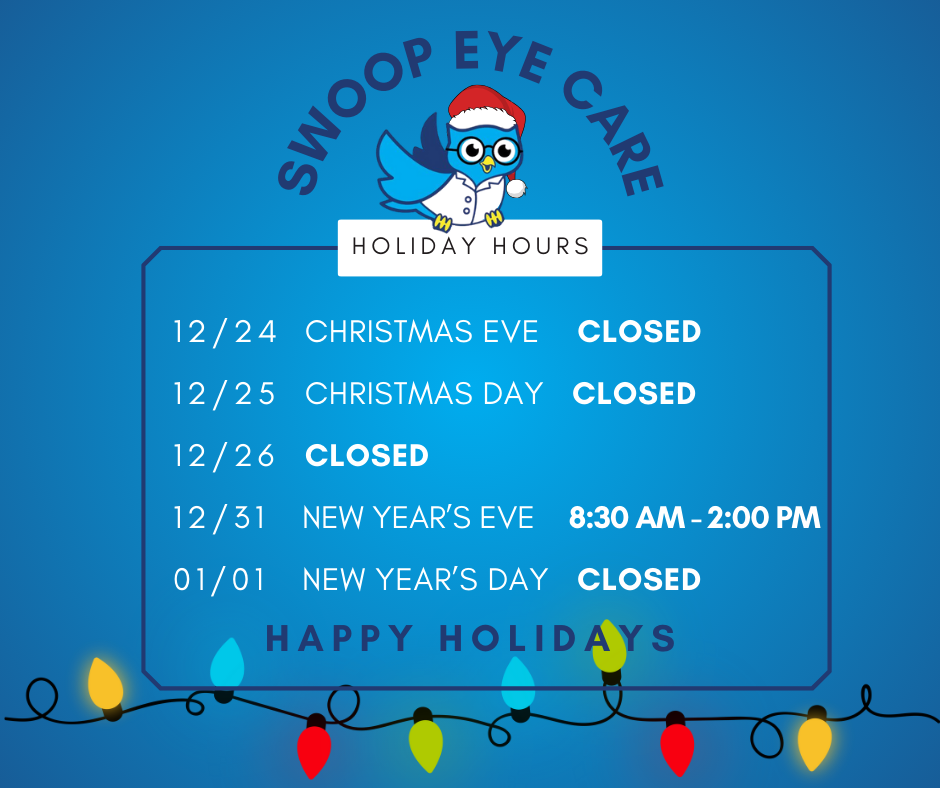Overview

During a comprehensive eye examination at Swoop Eye Care, your eye doctor will screen for vision-related problems & medical eye conditions such as glaucoma, cataracts, amblyopia, and others. We look forward to providing the best possible vision correction while also detecting and assessing systemic conditions such as diabetes, high blood pressure, cancer, and others. Your optometrist will walk you through their recommendations whether it be a new prescription for glasses and or contact lenses, a recommendation for specialty testing, or a referral to a specialist.
How often do I need an Eye Exam?
Adult: An eye examination is recommended at least every two years from age 18-64 unless followed for a particular systemic or eye condition.
Child: An eye examination is recommended at least once between 6-12 months of age. Then, at least once between ages 3 years and 5 years. It then should be completed annually from age 6 to age 17.
What to Bring?
- Current pair of eyeglasses (most often worn)
- Sunglasses (if prescription)
- Current contact lens prescription (or box of contacts)
- Any eye drops you are currently using
- List of current prescription medications
- Name, address, phone number, & fax number of Primary Care Provider and/or any specialists involved with your care
- Complete online paperwork prior to visit
What should you expect during an eye exam?
During and throughout your eye exam, the eye care technician and your optometrist will ask about your prior eye history, medical history, current & past medications, family medical/eye history, and many other important aspects. The doctor will ask about current symptoms or signs that impact your vision or eye health.
Your optometrist will use microscopes, lenses, and other digital technology to aid in the assessment of your eye health of the eye and surrounding structures of the eye. Dilating your eyes in the office is always recommended for patients with a history of systemic diseases (diabetes, hypertension, thyroid disease, and many others) and to ensure excellent eye health to rule out retinal disease (retinal detachments, retinal holes, retinopathy), optic nerve disorders (glaucoma, optic neuropathy, etc.) or macula conditions (macular degeneration, macular edema, etc.).
These tests or high-tech machines measure the curvature of the cornea (front surface of the eye) by focusing a circle of light on the cornea and measuring its reflection. This helps your optometrist with an initial start of your ophthalmic prescription, the best contact lens for your unique eye (based upon specific measurements) and other critical aspects to rule out underlying eye diseases.
The eye care technician and your doctor will check your eye pressures, which is one factor potentially leading to a disease called glaucoma. There are a number of ways to check your eye pressure. At Swoop Eye Care, we use a device called the iCare tonometer. There is no “air puff” utilized during this test, which has created a more seamless experience for our patients.
Your optometrist may look at several unique aspects of your vision or eye health that may include: depth perception, color vision, eye muscle movements, peripheral (side vision), pupil responses, and several other aspects pending your initial concerns.
To allow for a clear, single image, the eyes must work in concert or together to be able to change focus, move and work in unison. Your optometrist may test accommodation (ability to focus), ocular motility (eye movement), and binocular vision (the ability of your eyes to work well together) during your visit. This is especially important for more vulnerable patient populations (pediatrics, geriatrics, history of traumatic brain injury).
Your optometrist then uses an instrument called a phoropter or an autophoropter (electronic form) to determine your ‘refractive power’ to aid in the correction of nearsightedness, farsightedness, or astigmatism.
Visual acuity is the way your optometrist determines how well you can see at far distances or near. The doctor determines how well you can see. How well you can see is determined by vision correction or eye diseases.












